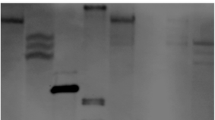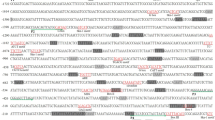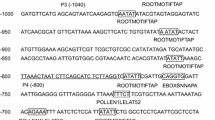Abstract
The beta-glucosidase (BGLU, EC 3.2.1.21) gene family in B73 maize contains 26 BGLU paralogs of unknown functional redundancy. Promoter sequences revealed that each paralog possesses a distinct set of cis elements and transcription factor binding sites that can modulate transcriptional activity in response to a variety of stimuli. Agrobacterium-mediated fast transient transformation is advantageous for studying large gene families in plants that have rapid recombinant protein expression. In this study, we applied an optimized method from tropical hybrids of maize seedlings in order to characterize some endogenous maize beta-glucosidase gene promoters to produce heterologous proteins. We evaluated germination kinetics and Agrobacterium susceptibility of NS9617, DK2038, and C/05 hybrids and one inbred (B-73) of which C/05 was the most susceptible hybrid to Agrobacterium infection. In order to investigate the promoter-driven gene expressions of BGLU2, BGLU5, BGLU7, and GLU12, 2 kb upstream nucleotides were cloned in pCAMBIA and pKGWFS7 vectors with β-glucoronidase (GUS) reporter (udiA) gene. GUS activity was quantified in root and leaf of C/05 maize seedlings, and two promoters (ZmBGlu2 and ZmBGlu5) were highly active in young maize seedlings comparable to the patented p35S CaMV viral promoter. We propose that the use of 9-day-old seedlings of C/05 for fast transformation assays is a rapid and cost-efficient alternative for protein characterization, functional evaluation of isogenes, and promoters. The maize cisgenic pZmBGlu2 and pZmBGlu5 promoters were expressed during germination (compatible with p35S CaMV), suggesting that they have potential heterologous protein expression and their use avoids intellectual property and biosafety conflicts.





Similar content being viewed by others
References
Armstrong C, Petersen W, Buchholz W, Bowen B, Sulc S (1990) Factors affecting PEG-mediated stable transformation of maize protoplasts. Plant Cell Rep 9:335–339. doi:10.1007/BF00232864
Bhaskar PB, Venkateshwaran M, Wu L, Ané J-M, Jiang J (2009) Agrobacterium-mediated transient gene expression and silencing: a rapid tool for functional gene assay in potato. PLoS ONE 4:e5812. doi:10.1371/journal.pone.0005812
Bolger ME, Weisshaar B, Scholz U, Stein N, Usadel B, Mayer KFX (2014) Plant genome sequencing—applications for crop improvement. Curr Opin Biotech 26:31–37. doi:10.1016/j.copbio.2013.08.019
Bradford MM (1976) A rapid and sensitive method for the quantitation of microgram quantities of protein utilizing the principle of protein-dye binding. Anal Biochem 72:248–254
Butron A, Chen YC, Rottinghaus GE, McMullen MD (2010) Genetic variation at bx1 controls DIMBOA content in maize. Theor Appl Genet 120:721–734. doi:10.1007/s00122-009-1192-1
Cavalar M, Moller C, Offermann S, Krohn NM, Grasser KD, Peterhansel C (2003) The interaction of DOF transcription factors with nucleosomes depends on the positioning of the binding site and is facilitated by maize HMGB5. Biochemistry-Us 42:2149–2157. doi:10.1021/Bi026761r
Chang WC, Lee TY, Huang HD, Huang HY, Pan RL (2008) PlantPAN: plant promoter analysis navigator, for identifying combinatorial cis-regulatory elements with distance constraint in plant gene groups. Bmc Genomics 9:561. doi:10.1186/1471-2164-9-561
Chee PP, Fober KA, Slightom JL (1989) Transformation of soybean (Glycine max) by infecting germinating seeds with Agrobacterium tumefaciens. Plant Physiol 91:1212–1218
Chumako MI, Rozhok NA, Velikov VA, Tyrnov VS, Volokhina IV (2006) Agrobacterium-mediated in planta transformation of maize via pistil filaments. Russ J Genet 42:893–897. doi:10.1134/S1022795406080072
Clough SJ, Bent AF (1998) Floral dip: a simplified method for Agrobacterium-mediated transformation of Arabidopsis thaliana. Plant J 16:735–743. doi:10.1046/j.1365-313x.1998.00343.x
Cominelli E, Galbiati M, Albertini A, Fornara F, Conti L, Coupland G, Tonelli C (2011) DOF-binding sites additively contribute to guard cell-specificity of AtMYB60 promoter. Bmc Plant Biol 11:162. doi:10.1186/1471-2229-11-162
D’Halluin K, Bonne E, Bossut M, Page R (1999) Transformation of maize via tissue electroporation. In, vol 111. pp 367-373
Dunwell JM (1999) Transformation of maize using silicon carbide whiskers. In, vol 111. pp 375-382
Esen A (1992) Purification and partial characterization of maize (Zea mays L.) β-glucosidase. Plant Physiol 98:174–182
Eudes A, Mouille G, Thevenin J, Goyallon A, Minic Z, Jouanin L (2008) Purification, cloning and functional characterization of an endogenous beta-glucuronidase in Arabidopsis thaliana. Plant Cell Physiol 49:1331–1341. doi:10.1093/Pcp/Pcn108
Finer J, and Dhillon, T (2008) Transgenic plant production In: Stewart CN (ed) Plant biotechnology and genetics pp 245-255
Fior S, Gerola PD (2009) Impact of ubiquitous inhibitors on the GUS gene reporter system: evidence from the model plants Arabidopsis, tobacco and rice and correction methods for quantitative assays of transgenic and endogenous GUS. Plant Methods 5:19. doi:10.1186/1746-4811-5-19
Frame BR et al (2006) Improved Agrobacterium-mediated transformation of three maize inbred lines using MS salts. Plant Cell Rep 25:1024–1034. doi:10.1007/s00299-006-0145-2
Gómez-Anduro G, Ceniceros-Ojeda E, Casados-Vázquez L, Bencivenni C, Sierra-Beltrán A, Murillo-Amador B, Tiessen A (2011) Genome-wide analysis of the beta-glucosidase gene family in maize (Zea mays L. var B73). Plant Mol Biol 77:159–183. doi:10.1007/s11103-011-9800-2
Graves AF, Goldman SL (1986) The transformation of Zea mays seedlings with Agrobacterium tumefaciens. Plant Mol Biol 7:43–50. doi:10.1007/BF00020130
Huang XQ, Wei ZM (2005) Successful Agrobacterium-mediated genetic transformation of maize elite inbred lines. Plant Cell Tiss Org 83:187–200. doi:10.1007/s11240-005-5772-8
Ishida Y, Saito H, Ohta S, Hiei Y, Komari T, Kumashiro T (1996) High efficiency transformation of maize (Zea mays L) mediated by Agrobacterium tumefaciens. Nat Biotechnol 14:745–750. doi:10.1038/Nbt0696-745
Karimi M, Inzé D, Depicker A (2002) Gateway vectors for Agrobacterium-mediated plant transformation. Trends Plant Sci 7(5):193–195
Kim K-W, Franceschi V, Davin L, Lewis N (2006) β-Glucuronidase as reporter gene. In: Salinas J, Sanchez-Serrano J (eds) Arabidopsis protocols, vol 323. Methods in molecular biology™. Humana Press, pp 263-273. doi:10.1385/1-59745-003-0:263
Kirienko DR, Luo A, Sylvester AW (2012) Reliable transient transformation of intact maize leaf cells for functional genomics and experimental. Stud Plant Physiol 159:1309–1318. doi:10.1104/pp. 112.199737
Komari T, Hiei Y, Ishida Y, Kumashiro T, Kubo T (1998) Advances in cereal gene transfer. Curr Opin Plant Biol 1:161–165. doi:10.1016/S1369-5266(98)80019-8
Li JF, Park E, von Arnim AG, Nebenfuhr A (2009) The FAST technique: a simplified Agrobacterium-based transformation method for transient gene expression analysis in seedlings of Arabidopsis and other plant species. Plant Methods 5:6. doi:10.1186/1746-4811-5-6
Li PH et al (2010) The developmental dynamics of the maize leaf transcriptome. Nat Genet 42:1060–U1051. doi:10.1038/Ng.703
Lozovaya V, Ulanov A, Lygin A, Duncan D, Widholm J (2006) Biochemical features of maize tissues with different capacities to regenerate plants. Planta 224:1385–1399. doi:10.1007/s00425-006-0328-7
Ma S, Wang A (2012) Molecular farming in plants: an overview. In: Wang A, Ma S (eds) Molecular farming in plants: recent advances and future prospects. Springer, Netherlands, pp pp 1–pp 20. doi:10.1007/978-94-007-2217-0_1
Marton LC (2013) Hybrid maize in Hungary is 60 years old. In: Spitko LCMaT (ed) 60 Years of Hungarian hybrid maize. pp 10-16
Matsumoto T, Keith L, Cabos RM, Suzuki J, Gonsalves D, Thilmony R (2013) Screening promoters for Anthurium transformation using transient expression. Plant Cell Rep 32:443–451. doi:10.1007/s00299-012-1376-z
Muhitch MJ (1998) Characterization of pedicel β-glucuronidase activity in developing maize (Zea mays) kernels. Physiol Plant 104:423–430. doi:10.1034/j.1399-3054.1998.1040318.x
Ombori O, Muoma JVO, Machuka J (2013) Agrobacterium-mediated genetic transformation of selected tropical inbred and hybrid maize (Zea mays L.) lines. Plant Cell Tiss Org 113:11–23. doi:10.1007/s11240-012-0247-1
Panthee DR, Pantalone VR, West DR, Saxton AM, Sams CE (2005) Quantitative trait loci for seed protein and oil concentration, and seed size in soybean. Crop Sci 45:2015–2022. doi:10.2135/cropsci2004.0720
Rao KS, Rohini VK (1999) Agrobacterium-mediated transformation of sunflower (Helianthus annus L.): a simple protocol. Ann Bot-London 83:347–354. doi:10.1006/anbo.1998.0828
Saxena KB, Faris DG, Singh U, Kumar RV (1987) Relationship between seed size and protein content in newly developed high protein lines of pigeonpea. Plant Food Hum Nutr 36:335–340. doi:10.1007/BF01892354
Schlappi M, Hohn B (1992) Competence of immature maize embryos for Agrobacterium-mediated gene transfer. Plant Cell Online 4:7–16. doi:10.1105/tpc.4.1.7
Schnable PS et al (2009) The B73 maize genome. Complex Divers Dyn Sci 326:1112–1115. doi:10.1126/science.1178534
Sekhon RS, Lin H, Childs KL, Hansey CN, Buell CR, de Leon N, Kaeppler SM (2011) Genome-wide atlas of transcription during maize development. Plant J 66:553–563. doi:10.1111/j.1365-313X.2011.04527.x
Shen S, Zhang X, Guo Y, Xing Y (2001) Microinjection of genes into in vitro ovaries of maize and identification of transformed plants. Acta Bot Sin 43:1055–1057
Sidorov V, Gilbertson L, Addae P, Duncan D (2006) Agrobacterium-mediated transformation of seedling-derived maize callus. Plant Cell Rep 25:320–328. doi:10.1007/s00299-005-0058-5
Valdez-Ortiz A, Medina-Godoy S, Valverde ME, Paredes-López O (2007) A transgenic tropical maize line generated by the direct transformation of the embryo-scutellum by A. tumefaciens. Plant Cell Tissue Organ Culture 91:201–214. doi:10.1007/s11240-007-9286-4
Wang K, Frame B (2009) Biolistic gun-mediated maize genetic transformation. In: Scott MP (ed) Transgenic maize, vol 526. Methods in molecular biology™. Humana Press, pp 29-45. doi:10.1007/978-1-59745-494-0_3
Wang JX, Sun Y, Li Y (2007) Maize (Zea mays) genetic transformation by co-cultivating germinating seeds with Agrobacterium tumefaciens. Biotechnol Appl Bioc 46:51–55. doi:10.1042/Ba20060065
Wang Y, Wu J, Kim SG, Kim ST, Kang KY (2013) A transient gene expression protocol for subcellular protein localization and protein secretion analyses in rice
Winter D, Vinegar B, Nahal H, Ammar R, Wilson GV, Provart NJ (2007) An “electronic fluorescent pictograph” browser for exploring and analyzing large-scale biological data sets. PLoS One 2:e718. doi:10.1371/journal.pone.0000718
Yanagisawa S (2000) Dof1 and Dof2 transcription factors are associated with expression of multiple genes involved in carbon metabolism in maize. Plant J 21:281–288. doi:10.1046/j.1365-313x.2000.00685.x
Zhang J, Boone L, Kocz R, Zhang C, Binns AN, Lynn DG (2000) At the maize/Agrobacterium interface: natural factors limiting host transformation. Chem Biol 7:611–621. doi:10.1016/S1074-5521(00)00007-7
Acknowledgements
We are grateful to Consejo Nacional de Ciencia y Tecnológia in Mexico for CONACYT-Basic Science Grants 156563 and 151818 and to CINVESTAV Irapuato and CIBNOR staff Martha Reyes and Mayela Ornelas for technical support and Diana Dorantes for English editing.
Author information
Authors and Affiliations
Corresponding author
Electronic supplementary material
Below is the link to the electronic supplementary material.
S1
Table showing the maximum values of gene expression of the β-glucosidases in Zea mays of Inbred line B73. (DOCX 17 kb)
S2
Schematic representation: Germination, cocultivation and GUS activity determination in days (DOCX 48 kb)
S3
Bioinformatics analysis of β-Glucosidases promoters. The sequences of the putative promoter region (2000 pb upstream start codon) of pZmBGlu2, 5, 7, 12 showing the transcription factor binding sites where one is the most distant position and 2000 is the nearest to the start codon. Each analysis was made with databases for maize from a database reported by (Chang et al. 2008). (PPTX 2542 kb)
S4
Histochemical GUS activity in cisgenic pZmBglu2 and pZmBglu5 and also 35S CaMV promoter. (DOCX 265 kb)
Rights and permissions
About this article
Cite this article
Rojas, M., Tiessen, A., Ascencio, F. et al. Two Promoters of Beta-Glucosidase Paralogs (ZmBGlu2 and ZmBGlu5) Highly Active in Tropical Young Maize Hybrid Seedlings. Plant Mol Biol Rep 33, 1666–1674 (2015). https://doi.org/10.1007/s11105-015-0863-0
Published:
Issue Date:
DOI: https://doi.org/10.1007/s11105-015-0863-0




